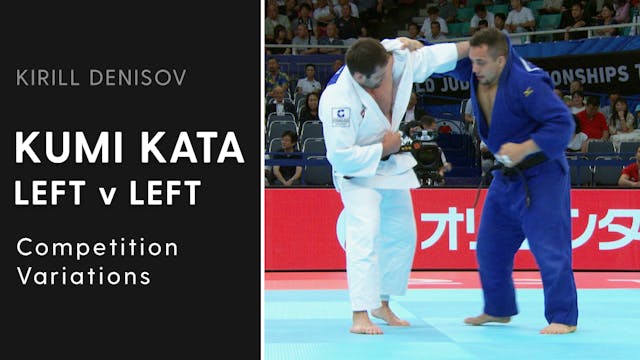Kirill Denisov says that whenever he fights left handed opponents, his first thought is always to have control of their left arm.
‘How do I catch the left arm’, he says. ‘How do I control it’.
With his opponents aware of his game-plan, they do as much as possible to prevent Denisov from catching the sleeve.
Coming out in a traditional left handed stance means that catching the sleeve outright is very difficult, as there is too much space between himself and the left arm.
By switching to a right handed stance he closes the gap between himself and the left side of his opponent’s body.
Although the sleeve is still difficult to catch, Denisov is now able to grip the left lapel.
This usually encourages the opponent to take a strong grip themselves, such as a high lapel.
Once the opponent has gripped up, Denisov switches back to his natural left stance and brings both his hands down onto the sleeve…
With one hand above the wrist and the other below.
He then takes a big step back, pulling with both arms and engaging the whole of his body.
As Denisov is up against a strong lapel grip, he must generate as much power as possible in order to pull the opponent towards him.
He tucks his elbow into his side, in the same way he does against right handers and aims to get his left hand on the back of the collar, tight to his opponent’s neck.
Look at how much power comes from the legs as he pushes off the mat with his feet.
By Denisov pulling on the opponent’s left sleeve he shifts their hand down his lapel and into a weaker position. He then retains an element of control, by keeping hold of the sleeve. And once he has his high, dominant, collar grip he is clearly the judoka with the gripping advantage.
If the opponent doesn’t grip up, Denisov has an alternative technique that still enables him to catch the sleeve, and then take the collar.
With the opponent’s sleeve still out of reach, Denisov pulls on the lapel, feeding it from his right hand into his left.
He then catches the sleeve, whilst using Ashi waza to help break his opponent’s balance.
The pull, combined with the Ashi waza, disorientates the opponent. Their focus shifts away from the upper body to their legs, as they attempt to regain stability.
Denisov points out the importance of always pulling the opponent, even when the sleeve is caught. The danger of shifting your weight towards your opponent when going for the collar grip is being countered with Ura nage. Therefore, he latches onto the collar, as opposed to throwing his arm at his opponent.
As with all encounters against same stance opponents, Denisov’s target is to first control the power hand.
Only then is he ready to think about his Tachi waza.
Up Next in Watch All
-
Preventing Cross Grips | Kumi Kata Le...
When Kirill Denisov is up against an opponent who takes a high cross grip, or ‘the Russian arm’, he has two very efficient ways of quickly dealing with this dangerous grip.
The Russian arm is very threatening, as an attack usually follows in quick succession.
Denisov’s response, therefore, has...
-
Adapting To Switch Of Stance | Kumi K...
If Kirill Denisov is up against a left handed opponent who targets his lapel with their right hand, he has a very effective way of turning defence into attack.
With the opponent switching their upper body stance from left to right, Denisov’s main objective is to prevent his left lapel from being...
-
Competition Variations | Kumi Kata Le...
One of Denisov’s most effective strategies against same stance opponents is to come out right handed before switching back to a left stance once gripped up.
Here’s a good example against Turkmenistan’s Hojamuhammedov in the 2018 Agadir Grand Prix.
Denisov leads with a right handed lapel grip, w...



